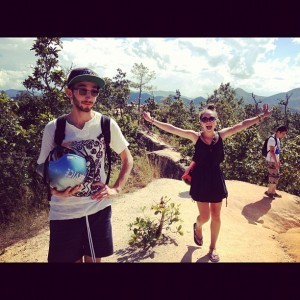Lisa Niver's Blog: We Said Go Travel, page 483
July 28, 2013
South Africa: The ‘Berg
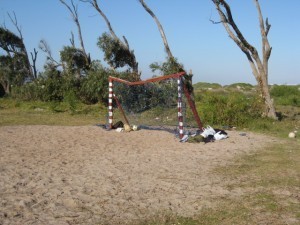 Two years ago I boarded a plane by myself to South Africa. I ignored my friends who called me crazy, and as much as I appreciated the concern from my family, I did not hesitate when I pressed the confirm flight button.
Two years ago I boarded a plane by myself to South Africa. I ignored my friends who called me crazy, and as much as I appreciated the concern from my family, I did not hesitate when I pressed the confirm flight button.
Two weeks later, I found myself staring out the airplane window, minutes before take-off, wondering if…”maybe I was crazy?” It took all of two minutes, and the plane to take-off, for me to convince myself this was the exact thrill I needed after graduating University.
With 25 hours of travel time ahead of me, I started to think of what was in store for me in the next four months. To be honest, I only knew of a few things: I’d be living with 18 to 25 strangers from all around the world, in a small living space, and that I’d be volunteering in a township coaching soccer to underprivileged children during the 2010 World Cup. I pinched myself, but I was still hundreds of feet in the air, on my own, to take on whatever the motherland had to offer.
It was May 15, 2010 when I found myself walking down the arrival hall in the Cape Town International Airport in hopes of meeting someone from the volunteer program to pick me up and take me to my new home for the next few months. It was not even 7 in the morning and the sun beaming through the airport windows was warm against my skin. Distracted by the view outside, I nearly missed the petite woman calling my name over and over. “Jenna? Jenna?” I walked up, and said, “ I’m Jenna, and I have made it.”
One Month Later
It didn’t take long for me to settle in, meet the other volunteers, and make myself at home in a small town outside of Cape Town, known as surfer’s corner, or the ‘Berg, or Muizenberg. The ‘Berg was a small paradise. I lived within walking distance to the beach that was surrounded by breathtaking views of mountains that seemed to go on forever. It also didn’t take long for the 25 volunteers, to become like a family. We might have all been in different volunteer programs, some teaching, some surfing, and some coaching, but we all came to the ‘Berg for one reason…the kids.
The first time I made the 45-minute walk into Capricorn town-ship to the school where I’d meet the boys I’d be coaching for the next four months, I went into shock. I had imagined what town-ships looked like, but when I was standing in the streets right in the middle of one, I couldn’t help my emotions. Garbage was piled high with kids climbing to the top, the water where a few were swimming looked more like a swamp, and the amount of stray dogs roaming around, sent chills up my spine. Then out of nowhere, a young boy came up to me and grabbed my hand. I snapped out of my daze, and looked down at the boy. Although, he was missing his front teeth, he had the biggest smile I had ever seen. He looked up and said, “Teacha, are you the next football coach?” I said yes, and before I knew it he was yelling, “the coaches are here, the coaches are here.”
I was home.
At 2 pm each afternoon the four coaches would make the long walk to the school where we would grab the limited amount of equipment, and the boys to walk them to the field where we practiced each day. The field looked more like a beach, covered in sand with two wooden nets barely standing together at each end. However, this field was where these 11-year-old boys could forget about running home before dark because it was too dangerous to be alone after 5 pm, or where they wouldn’t have to worry about being bullied or pressured into drugs, this field is where these boys were allowed to play soccer, and just have fun. For a lot of these boys, this sandy field was where they dreamt of one day playing for Bafana, Bafana.
Some may believe freedom comes when you are alone on a beach with nothing, but the sound of waves in the background. Or maybe you’re at peace in the comfort of your own home. But if someone told me I would feel the most free in the middle of one of the most dangerous townships in Cape Town, South Africa, on a sandy field coaching boy’s soccer, I would never have believed them.
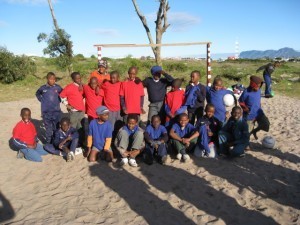 Two years later, I still hold the ‘Berg close to my heart. The boys I coached became like family. Most of them struggling to stay away from the pressures of joining the gangs within the township, or some having to take care of their younger siblings because that’s all they had. With struggle comes true strength, and the amount of strength and fight these boys had became an inspiration for me. I wasn’t just coaching a soccer team; I was apart of something bigger that summer. As the World Cup took over South Africa, there was complete joy on every little boy’s face as they put on their cleats, to play the nation’s national sport. When we took the field to scrimmage with the kids, I have never felt more alive. These kids who have seen family members be shot, or go days without eating, or have next to nothing had taught me what true happiness is…and that’s to enjoy and take advantage of what you do have. And that’s freedom. And I just so happened to find my freedom a thousand miles from home in a middle of a dangerous township in a small town known as. ‘the ‘Berg,’
Two years later, I still hold the ‘Berg close to my heart. The boys I coached became like family. Most of them struggling to stay away from the pressures of joining the gangs within the township, or some having to take care of their younger siblings because that’s all they had. With struggle comes true strength, and the amount of strength and fight these boys had became an inspiration for me. I wasn’t just coaching a soccer team; I was apart of something bigger that summer. As the World Cup took over South Africa, there was complete joy on every little boy’s face as they put on their cleats, to play the nation’s national sport. When we took the field to scrimmage with the kids, I have never felt more alive. These kids who have seen family members be shot, or go days without eating, or have next to nothing had taught me what true happiness is…and that’s to enjoy and take advantage of what you do have. And that’s freedom. And I just so happened to find my freedom a thousand miles from home in a middle of a dangerous township in a small town known as. ‘the ‘Berg,’
About the Author: My name is Jenna Gonneau. I am prone to wander ever since booking my first solo trip to South Africa in 2010. Since then I have been back to Africa, camping through seven different countries, then backpacked through SE Asia for half a year. I am a writer who is currently planning my next adventure…
The post South Africa: The ‘Berg appeared first on We Said Go Travel.
Awka in Nigeria: A Good Place of Independence
 Awka in Nigeria: A Good Place of Independence
Awka in Nigeria: A Good Place of Independence
Introduction
Independence is to be free from outside control; not subjected to another’s authority. Awka is a good place that worth being because of the benefits attributed to it. All who travelled there for holidays testified and are still testifying on the good platform of the area.
What makes Awka Unique Place for Travellers?
Food is the fundamental thing that man needs to continue in his existence. This can make a dry bone turn over a new leaf within a short time. Awka has a fertile land for agricultural growth. Food scarcity is a dead talk in this part of the world.
Another thing that is special is the skill display in this society. The community has men who are skilled in blacksmithing. Without education, these men can manufacture many tools on their own. This is no tall story at all. Most times I cherish going to the workshops and admire the neat works of the craftsmen. To my surprise, do you know that these men produce guns using the local forging process?
This area is rich in cultural and tradition practices. The traditions of many communities of the world had been washed up. This is not so in Awka. The area booms in displaying their traditions. I really enjoy some of these, mainly during their cultural festivals. Their attire and masquerade parade is a notable one.
The community is a good business area. There is competition in the business establishment around the area. Because of this, goods are sold at cheaper price. Whenever I travel to this part of Nigeria, I like buying everything I need. The talk of “if you do not buy if from my shop, you will not see it in any other place” is an outdated one.
Awka has well furnished hotels where one can go and relax. I feel as if I am in paradise any time I enter any of these hotels. Examples of the notable ones are: Queens Suites; White View; and Rest Point. These are maintained to the standard. The way the workers treat her customers is outstanding.
It is well known that wildlife has gone into extinct in different parts of the world. Many have not tested bush meats since birth. In Awka, this is at all and sundry’s reach. These bush meats are sold at many joints in the town. They have unique tests that make them what they are. Honestly, you need to travel to this part of the world to enjoy the good breeze.
 Another outstanding thing about Awka is that it has many fresh waters that house many aquatic animals. One of the aquatic animals I like enjoying in that place is the fish. They have special qualities in them that make them singled out from other fishes. I feel free any time I eat these fishes. This is different from those bought from fish farmers. Those from fresh water are matured and have all that nature gives to it. There is no room for having second thoughts on whether to go to this society to exercise your freedom. You really need it.
Another outstanding thing about Awka is that it has many fresh waters that house many aquatic animals. One of the aquatic animals I like enjoying in that place is the fish. They have special qualities in them that make them singled out from other fishes. I feel free any time I eat these fishes. This is different from those bought from fish farmers. Those from fresh water are matured and have all that nature gives to it. There is no room for having second thoughts on whether to go to this society to exercise your freedom. You really need it.
Today, we construct artificial rivers in the name of swimming pools. But, listen let me tell you, it is not so in Awka. In some cases, people go to these swimming pools and die in them when they jump and break their heads on the cemented floor. There are well maintained rivers in Awka where one can go and swim at ease. I feel highly independent any moment I touched this part of the town.
Conclusion
To travel is another means of freedom. There are many good associated with travelling as explained above.
About the Author: Mike Uzochkwu: I am a fourth year undergraduate student in Nnamdi Azikiwe University, Nigeria. I am from Anambra state, Nigeria. Find him on Facebook.
The post Awka in Nigeria: A Good Place of Independence appeared first on We Said Go Travel.
Sri Lanka: Free to be Me
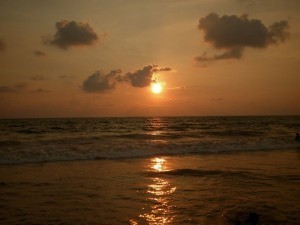 A never ending sky. The grey-black clouds speak of a dusk, yet to arrive. The sun is still visible. But this is not the arrogant, scorching sun of noon; it is a gentle, mellow light that paints its surroundings in vibrant hues. Sometimes, you may see a boat, dot the horizon. An infinitesimal entity, gliding towards, a seemingly infinite space.
A never ending sky. The grey-black clouds speak of a dusk, yet to arrive. The sun is still visible. But this is not the arrogant, scorching sun of noon; it is a gentle, mellow light that paints its surroundings in vibrant hues. Sometimes, you may see a boat, dot the horizon. An infinitesimal entity, gliding towards, a seemingly infinite space.
This is the seaside town of Mount Lavinia, Sri Lanka. – Sri Lanka is a tiny island nation, nestled in the Indian Ocean. It’s lush, varied landscape, belies its very size. Mountainous terrain and an endless beach, lie within a few hundred kilometers of each other.- Here, at the Mount Lavinia beach, you feel at peace. A peace that was, once, hard to envision, in a country marred by a civil war, spanning over twenty five years.
The golden sand trickles through your toes. You long to build sand castles the way you did when you were small. And here, you can. Because, this is a place where you do not mind what others may think. Here, you are free to be your innermost self. And nostalgia is banished; as you pick up little shells to decorate your castle, and dig deep into the sand to build your own moat. You know that within a few minutes, a few hours or within the span of a day, the inevitable will come to pass, and the waves will carry your castle away to sea; but on this beach, it is only the here and now that matters.
The ash blue ocean beckons, enticingly. Captivated, some wade into the water, where white tipped waves break across their feet. The more intrepid, swim out to sea. Shrieks of glee can be heard at times, as the waves catch people unawares. Some, who have come to the beach fully clothed, are drenched, due to the unpredictability of the ocean. Yet, seemingly no one cares. The worries of the boardroom and the burdensome workloads of everyday life, are left far, far behind. The vastness of the ocean holds a compelling magic that somehow, seems to wash life’s trivialities away.
The tall, coconut fronds swish and rustle to the tune of the inescapable wind. Lightly plaited hair and loosely tied pony tails, cast their hair grips asunder, and fly wildly, unrestrained. Coupled with sea spray, hair tastes salty, here, as it swirls around your face. Free, at last.
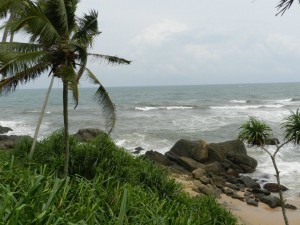 A few, wooden fishing boats lie quietly on the sand. They, the children of the night, are idle, now. But in a few hours, fishermen, dressed in loincloths or shorts, will be seated in these boats, with their nets cast out. The livelihood of these fishermen, who live in thatched huts on the beach itself, is almost entirely dependent on the bounties of the ocean. Unfettered with material possessions; they sail the seas, with a simple trust, that is touching to see.
A few, wooden fishing boats lie quietly on the sand. They, the children of the night, are idle, now. But in a few hours, fishermen, dressed in loincloths or shorts, will be seated in these boats, with their nets cast out. The livelihood of these fishermen, who live in thatched huts on the beach itself, is almost entirely dependent on the bounties of the ocean. Unfettered with material possessions; they sail the seas, with a simple trust, that is touching to see.
Never has Blake’s words seemed more appropriate than at the Mount Lavinia beach:
“To see a world in a grain of sand,
And a heaven in a wild flower,
Hold infinity in the palm of your hand,
And eternity in an hour.”
About the Author: My name is Layanthi Tennekoon. I qualified as an accountant; but now, I engage in freelance writing, because that’s something I truly love to do. It also means, that this way, I get to spend more time with my little son, who means the world to me. I like reading, learning new skills and meeting new people, as each in their own way, gives me a fresh perspective on the world.
The post Sri Lanka: Free to be Me appeared first on We Said Go Travel.
July 27, 2013
Japan: Forca Brasil
 It wasn’t until the Japanese cover band performed “Stand by Me” that the Brazilian flags were raised, a blaze of electric yellow, green and blue waving gloriously against the clear skies of Nagoya’s late afternoon sunshine. Seated on a picnic table in Japan’s Central Park with a plate of yakitori, I watched as sixty or so men, women, and children dressed in Brazilian colors, some with painted faces and many more with flags, filtered onto the dance floor. As they linked arms and swayed, hundreds of Japanese passersby, perusing through the area’s renowned high end fashion strip, paused to watch.
It wasn’t until the Japanese cover band performed “Stand by Me” that the Brazilian flags were raised, a blaze of electric yellow, green and blue waving gloriously against the clear skies of Nagoya’s late afternoon sunshine. Seated on a picnic table in Japan’s Central Park with a plate of yakitori, I watched as sixty or so men, women, and children dressed in Brazilian colors, some with painted faces and many more with flags, filtered onto the dance floor. As they linked arms and swayed, hundreds of Japanese passersby, perusing through the area’s renowned high end fashion strip, paused to watch.
Six months into my eighteen-month stay in Nagoya, Japan, during which my husband was to work and I, having left my corporate HR job, was to write, I was used to being one of the only non-Japanese of thousands on any given day. I had done my research prior to packing up my Detroit home and moving halfway around the world, and knew that in a country of nearly 128 million people, 98.5% were of Japanese ethnicity, followed by 0.5% Korean and 0.4% Chinese.
So where were all of the Brazilians coming from? And why were they carrying flags?
Thankful for modern technology, I quickly Googled “Brazil holidays”. Nothing. A soccer game? Nada. Brazilians-living-in-Japan day? Nope. As the song reached its conclusion I noticed some of the women had tears in their eyes. Many people were holding signs that read “Força Brasil”. But it wasn’t until several figures walked past in the white plastic protest masks I had seen on news the world over that I knew the gathering was political. Rather than speculate, I made my way through the crowd to learn more.
I headed towards a kind-looking man about my age who had a flag wrapped tightly around his shoulders.
“Hello!” I shouted over the music. “Do you speak English?” We were in Nagoya, after all, where very little English was spoken.
“Ha! Do I speak English!” He elbowed his friend, who laughed. Did that mean yes?
“What is going on here today? I am interested to know.”
“Today, here, well….” He trailed off into a series of Portuguese words. He then flagged over a friend from the dance floor to serve as interpreter.
A woman with long beautiful hair and high arched eyebrows, also in her early thirties, communicated the reason behind the patriotism.
“In Brazil is bad right now. We love Brazil as our country but we move – to here, to U.S., to Europe – for better education, for wages, for healthcare. The government, they hike fares, they spend millions on the World Cup and we Brazilians, we just grow poorer. The peaceful protests today, is to support the movements that is occurring in Brazil; we will always fight for our country. It is sad, because we want to stay in the country we love, you know?”
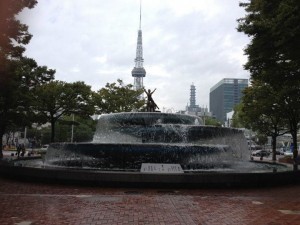 I nodded, thinking of my own family’s history and sacrifices. My father’s paternal grandparents had fled Hungary for a better life in America at the turn of the twentieth century, and my mother’s paternal grandparents had made a harrowing, blind voyage from conflict-ridden Macedonia to Detroit in 1919. If it weren’t for the courage of my ancestors, for their faith in the opportunity and prosperity America afforded, I may never have known the independence and freedom of the life I had grown to love, a life that had taken me all the way to Japan.
I nodded, thinking of my own family’s history and sacrifices. My father’s paternal grandparents had fled Hungary for a better life in America at the turn of the twentieth century, and my mother’s paternal grandparents had made a harrowing, blind voyage from conflict-ridden Macedonia to Detroit in 1919. If it weren’t for the courage of my ancestors, for their faith in the opportunity and prosperity America afforded, I may never have known the independence and freedom of the life I had grown to love, a life that had taken me all the way to Japan.
But how had so many Brazilians come to live in Japan, a country notoriously tight-lidded on immigration?
I was surprised to learn I had it backwards – it was the Japanese that had first moved to Brazil. About a century ago, the woman explained, many Japanese migrated to Brazil to work as labor on farms. They stayed and raised families, and when in the 1990s the Japanese government was looking for laborers, the Japanese-Brazilian population began returning to Japan to work in industries. As my great-grandparents had done, in a time of economic hardship, these people had bravely left their country in search of a better future.
And what did força mean?
Força meant force. It stood for strength, passion, energy, power. It stood for the effort of the people. It also meant “hang in there.” I knew what it was like to feel like a stranger in a strange land, far from the place you called home. Like the group in the park that day, my ancestors, through their bravery, had afforded me the freedom, the choice, to move or to stay. I followed the woman into the circle, knowing that while change does not happen overnight, the more voices that join the movement, the louder those voices are heard.
About the Author: Shannon Guerreso is a writer, an inventor, an entrepreneur and a world traveler. A Detroit native, she currently resides in Nagoya, Japan, where she is working on a collection of short stories and a variety of narrative nonfiction. She blogs about her life in Japan and other travel experiences at sashimiandthecity.blogspot.
The post Japan: Forca Brasil appeared first on We Said Go Travel.
Jewish Exponent Article on Jewish Celebrations
(Click on the image to open in a new window)
The post Jewish Exponent Article on Jewish Celebrations appeared first on We Said Go Travel.
Disney World: To infinity…and beyond!
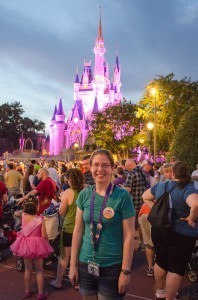 After a grueling six-month search, my boyfriend Zachary had finally landed a great job on the East Coast, about 45 minutes from where I work. That was a welcome change from the three-thousand-mile distance between us during our two years after college, when he attended grad school in California and I started my career in Massachusetts.
After a grueling six-month search, my boyfriend Zachary had finally landed a great job on the East Coast, about 45 minutes from where I work. That was a welcome change from the three-thousand-mile distance between us during our two years after college, when he attended grad school in California and I started my career in Massachusetts.
To celebrate our reunion, we planned a last-minute trip before Zachary started work in two weeks. We decided to experience Walt Disney World in all of its splendor. Neither of us had visited as children, even though we had seen every Disney movie countless times. It would be a great last-hurrah to our childhoods and a good launching point into our now-fully-adult working lives.
Since we only had five days before our desired departure date, we needed to move quickly on trip planning. We brought out our type-A planning skills and easily put together a vacation package through the Walt Disney World website.
Because Disney makes planning a trip so effortless, we had the freedom to plan experiences, not logistics. The only thing left to do was scour travel guides and pack our 5 days and 4 nights to maximum capacity. Our rallying cry became, “To infinity…and beyond!” from Toy Story, my all-time favorite Disney movie. How many rides, meals, and experiences could we cram into this trip? We were aiming for infinity.
To achieve this goal, we made heavy use of “touring plans” at the back of our heavily-thumbed-and-annotated Unofficial Guide to Walt Disney World. Using data collected from years of research in the parks, touring plans are itineraries that maximize the time spent experiencing rides and attractions while minimizing waiting times. Our engineering hearts simply drooled at the possibilities held in these heavily-optimized schedules.
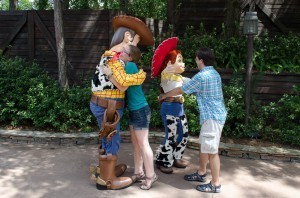 However, our best-laid plans were foiled half-way through our first morning as we careened off Big Thunder Mountain (stop number nine on our “Magic Kingdom in a Day” touring plan). We rounded a corner and suddenly spotted Woody and Jessie from the Toy Story movies, in a rare pop-up character stop in this tucked-away corner of Magic Kingdom.
However, our best-laid plans were foiled half-way through our first morning as we careened off Big Thunder Mountain (stop number nine on our “Magic Kingdom in a Day” touring plan). We rounded a corner and suddenly spotted Woody and Jessie from the Toy Story movies, in a rare pop-up character stop in this tucked-away corner of Magic Kingdom.
Here they were, the loyal Woody and the spunky Jessie, my favorite Disney characters and childhood role models come to life…and without even thinking, I said goodbye to our plans and our timelines, spun around to face Zachary and blurted, “I NEED TO SAY ‘HI,’ TO JESSIE AND WOODY NOW.”
As we waited in the ubiquitous Disney World line, I couldn’t stand still. I checked the settings on my DSLR for the tenth time, making sure I was ready to capture the big moment. What has gotten into me? I wondered. The clock was ticking — every minute we spent in line was another minute we weren’t on a ride or meeting our lunch reservations. But I didn’t care. All that mattered to me was that I meet two of my childhood heroes.
As the line moved forward, I watched the children take their turns meeting Woody and Jessie. While some were a bit shy, most interacted as they would when meeting an old friend — big excited eyes, a huge smile on their faces, and arms outstretched to welcome these life-sized characters. They weren’t worrying about the return time on their Fastpass for Space Mountain or their 1:05pm lunch reservations. They were totally in the moment, free to make this memory as good as it could be.
 Seeing the children made me realize that I was trying to experience Disney World through an adult’s eye, with plans and expectations for our experiences. But I think Walt Disney wanted all visitors, young and old, to see his world through a child’s eye. On the surface, it seems like Disney World is everything but spontaneous and unstructured, but Zachary and I found that the structure actually freed us from worrying about the logistics. We were as free as kids to discover the magic around the next corner.
Seeing the children made me realize that I was trying to experience Disney World through an adult’s eye, with plans and expectations for our experiences. But I think Walt Disney wanted all visitors, young and old, to see his world through a child’s eye. On the surface, it seems like Disney World is everything but spontaneous and unstructured, but Zachary and I found that the structure actually freed us from worrying about the logistics. We were as free as kids to discover the magic around the next corner.
After our meeting with Jessie and Woody, Zachary and I still stuck to our touring plans. But instead of adhering to them religiously, we saw them more as outlines for our experience. Our plans were a freeing structure that supported soaking up all the magic of Disney World, even if that meant missing a ride or two. That’s why, when we ran into Buzz Lightyear in Tomorrowland later in the day, we didn’t hesitate to stop and say, “Hi.”
“To infinity…and beyond!” indeed.
About the Author: Leslie Gerhat is an engineer, reader, writer, and explorer. She shares her thoughts and ideas with the world on her site, Explorer Leslie.
The post Disney World: To infinity…and beyond! appeared first on We Said Go Travel.
Realizing Freedom in Thailand
On my first ever trip overseas (other than ferries) I arrived in Bangkok alone, with only the advice of friends and travel
books giving me and idea of what to expect. I would spend over a month in Thailand as my stepping stone into the countries of Southeast Asia. Perhaps because it was the first foreign place I travelled to alone, and the catalyst to what would be an amazing adventure in new places, but Thailand resonated with me the most a feeling of pure freedom.
Not only did I feel liberated in my thoughts, knowing I was thousands of kilometres away from my home country full of people and places laced with familiarity, but also in my actions, unbound from the ties of menial responsibilities and petty pressures, free to let my energy flow where it should. Learning and growing.
There are countless experiences I was fortunate to have here that all contribute to the aura of freedom I felt so strongly in this beautiful place. Waking up in the morning and getting to make the ever changing decision of where to go for
breakfast; falling asleep with no blankets because they’re just not necessary; meditating for hours in a stunning temple escaping from your own thoughts and the outside world; sharing the ocean playground with whalesharks in clear waters; meeting amazing people from all walks of life that remind us we are never alone; hiking through the northern jungle and picturing your coordinates on a map; driving a moped down the highway amidst spectacular mountains and canyons; seeing the works of many generations ago and getting to learn about a culture not from books but through first hand experiences; ordering extravagantly from the dinner menu on occasion because, well, you can. The list goes on, from the small to the big. If you want to do something, stay somewhere or leave at the flip of a coin, and having the choice is amazing.
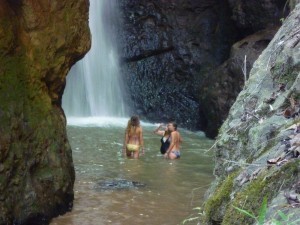 I believe when all the buffers and restrictions are erased, you can realize your true self. Being here allowed me to realized this freedom, giving me a little push out the proverbial door, confirming what my true self had been telling me. I could see it in a wrinkled mothers smile, feel it in the rawness of the jungle and in the breathtaking sunsets over the Andaman Sea, signifying our impermanence, and thus, our freedom.
I believe when all the buffers and restrictions are erased, you can realize your true self. Being here allowed me to realized this freedom, giving me a little push out the proverbial door, confirming what my true self had been telling me. I could see it in a wrinkled mothers smile, feel it in the rawness of the jungle and in the breathtaking sunsets over the Andaman Sea, signifying our impermanence, and thus, our freedom.
Independence in a world where we all must co-exist and work together to create beautiful lives. Visting the ‘land of smiles’ confirmed this for me. And once you taste true freedom, there’s no turning back.
About the Author: Jessie Le Couteur is a peanut butter loving yogi, wanna-be mermaid who enjoys dancing, painting, writing, swimming and music that forcefully makes you move, among other things. She is from Canada, mainly BC and New Bruswick, and has been moving around the beautiful country since toddler-hood, exploring and seeing what our amazing world has to offer. She likes to share ideas and stories through pictures and words via her blog: www.moonroots.wordpress.com
The post Realizing Freedom in Thailand appeared first on We Said Go Travel.
July 26, 2013
India: Spellbinding Jaisalmer
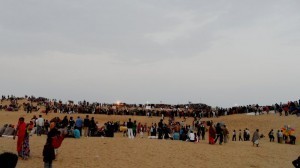 In the middle of the endless, dry desert suddenly there was a riot of colors. People decked in bright colors were sprouting vividly in barren of the mighty Thar. Heartrending music, the setting sun and the adorned camels ready to gallop with you. It was a carnival. It was Sam!
In the middle of the endless, dry desert suddenly there was a riot of colors. People decked in bright colors were sprouting vividly in barren of the mighty Thar. Heartrending music, the setting sun and the adorned camels ready to gallop with you. It was a carnival. It was Sam!
At the annual festival of Sam in Rajastan, India, I made friends from all over the world Austria, New York, Brazil and Germany! They were world travelers and it was my first outing solo. I had so much to learn, so much to explore. Traveling alone has many advantages one of them is, you are not confined to only your group of friends, and you can meet new people and can bid a polite goodbye if you want to be alone again.
Next day we booked a camel-safari to explore the interiors of the mysterious desert. We got one camel each and rode in the quiet of the majestic Thar admiring the beautiful golden landscape. Our camels were moving at different paces and mine was the slowest. I was left far behind and could faintly hear the camel man (Subhan Khan) say, “All ok everybody?” (Don’t expect vast, treeless undulating expanse of sand in Thar. The desert is not an endless stretch of sand dunes, bereft of life or vegetation. Thar Desert is highly ‘generic’ for it becomes lush green with slightest precipitation.)
Two hours on the galloping giant my back was threatening some serious pain. All I wanted was to get down and stretch on the soft (unmoving) desert. Every time there was a slant and the camel jerked going down, I screeched like a little girl. “I will be grateful to walk on my two feet now,” I begged Shubhan to let me down!
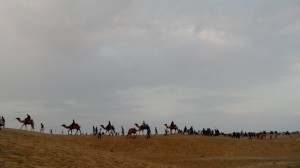 For fuel to make dinner we gathered dried camel dung and some twigs. We picked our spots in the vast Thar under the open sky and curled-up in our beddings. It was a full moon night with clear sky and all visible constellations. I set my phone alarm for 6.30, so that I don’t miss the sunrise.
For fuel to make dinner we gathered dried camel dung and some twigs. We picked our spots in the vast Thar under the open sky and curled-up in our beddings. It was a full moon night with clear sky and all visible constellations. I set my phone alarm for 6.30, so that I don’t miss the sunrise.
When my alarm rang in the morning, nobody was awake and there was no sun in sight, I kept snoozing it and peeping out of my blanket every ten minutes hoping to see sunlight. It was eight and the sun seemed to go on a strike.
Suddenly there was light in the sky. Sun? No it was lightening and thunder. It started raining!
After fifteen minutes of the rain drama the sun shined through. The camel-men perform magic out of bare minimum utensils and basic ingredients. We are served breakfast of porridge, fried-eggs, toast, jam, fruits and tea. The desert is full of surprises!
Back in the hotel my back failed me and I do nothing but sleep, eat and sleep some more. But who was in the hurry to do anything!
Me and my two other girlfriends plan a trip to Kuldhara, a deserted village twenty kilometers from Jaisalmer. We rented three bicycles for our crazy-adventure. Paddling and singing “Main herz tantz” we rode… I had never felt so light and happy. Such rapture! My heart was actually dancing. This was it! I knew was born to travel.
A lonely road with a couple of houses sited at far distances; we heard hisses of desert-snakes and loud Bollywood songs playing on the passing tractors once in a while. But mostly it’s quiet.
Phisssssssssssssssssssssss………………….. Naah…Not a snake! Marlous’s cycle had a puncture. We were not prepared for that.
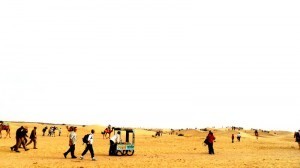 We walked for a kilometer and find a repair shop. But the tube was busted so Marlous and Flavia decided to hitch hike back while I continued alone.
We walked for a kilometer and find a repair shop. But the tube was busted so Marlous and Flavia decided to hitch hike back while I continued alone.
The road to Kuldhara is made on the dunes so it’s up-down-hill. I was full of energy and excitement, singing and riding I paddled. But the real deal was coming-back!
I was glad the girls had gone back and escaped this torture. I ate five oranges, one chocolate bar, chana and drank three bottles of water and my stomach still growled. I had no energy left to ride uphill; I got down and pushed the bike and myself every time there was an ascending ride. But I refused autos and tractors offering to give me and my bike ride home. I had to do it by myself!
My legs were shaking and my mouth was dry. Panting, trembling, huffing, I kept riding, thinking about how am going to brag it to my friends! That’s my only motivation.
I reached the bicycle shop with my head held high in pride and legs shuddering in pain. I could hardly walk. Dragging myself to the hotel, I knocked at Flavia’s room, “I did it,” “And I am hungry” I announced!
I was happy, I was free. I continued random traveling for another month and joined my job back in Pune, ten pounds lighter in body and a thousand pounds lighter in heart!
About the Author: Anuradha Beniwal: I have been traveling solo from past 3 years. And I want to promote female-solo-traveling in India. Indian women are always guarded and are never allowed to go anywhere alone. The women who have the chance to travel are scared to do it alone. Though my website I want to encourage women to travel alone and tell them how liberating it can be!
The post India: Spellbinding Jaisalmer appeared first on We Said Go Travel.
Dublin Freedom Walk
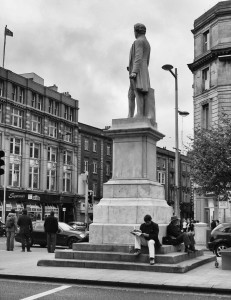 Very few places I have traveled have felt like home. I’ve lived in several states in the US, and visited different countries in my limited time here on earth. Needless to say, I am American through and through, apple-pie, red, white and blue. Few places capture my heart and make me feel free, as does Dublin Ireland. I agree with James Joyce who once said, “When I die, Dublin will be written in my heart.”
Very few places I have traveled have felt like home. I’ve lived in several states in the US, and visited different countries in my limited time here on earth. Needless to say, I am American through and through, apple-pie, red, white and blue. Few places capture my heart and make me feel free, as does Dublin Ireland. I agree with James Joyce who once said, “When I die, Dublin will be written in my heart.”
I lived in Ireland for almost a year and became immersed in the city and it’s culture. My family emigrated from Ireland just before the American Civil War, thus making my own Irish linage rather thin. However, every time I visit Dublin, my very thin Irish ancestral blood boils with anticipation for a long awaited homecoming.
Dublin is a very walk-able city; it’s not a very large. Street signs are mostly easy to find and both in English and Irish (Gaelic). The Irish joke that the street signs are in both languages so that you can get lost in both languages. The city begs for you to stroll its streets just as the poets and philosophers of old.
You can take in the some of the best parts of Dublin by beginning your day at St Stephen’s Green. Easy to get to, it’s one of the main parks in city Centre. The Green is Irelands best-known Victorian public park. Strolling through the park you find many water and flower gardens, sculptures, and unique structures such as the delicately carved Victorian Swiss shelter in the center of the park. The park also has a good children’s playground. On weekends, many artists selling their works often surround the Green.
Exit the parks northwest corner through the Fusiliers’ Arch and cross the street to Grafton Street, one of Dublin’s best shopping districts. You will find many unique shops, tourist traps and restaurants on Grafton Street. If you’re hungry, grab some excellent Italian food at Pasta Fresca on nearby Chatham Street. If you’re looking for a snack, about mid way through your walk on Grafton Street, you will find one of my favorite places to get a cup of tea or coffee and croissant: Bewely’s Café.
At the end of Grafton Street you will find Trinity College. Many folks will visit the historic and beautiful book of Kels and the breath-taking Library, which are fantastic, but walking the grounds of the campus is well worth the time. The hustle and bustle of the city falls away as the peaceful campus invites you to wander and admire the architecture and walk ways. Get away from the crowds and you will see another side of Trinity that many don’t bother to see.
Across the street from Trinity are a couple of great stores worth a look. Stop off at Books Upstairs, and pick up book of poems by Yeats, or a book on philosophy from Thompson (if your into books on anti-capitalism). Books Upstairs is an eclectic store similar to those found near college campuses throughout the world.
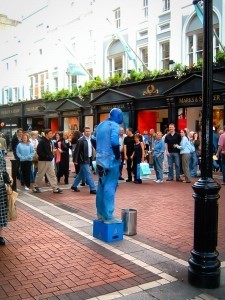 Once you cross the river you are on O’Connell Street. O’Connell street claims to be the heart of Dublin’s urban center and is lined with several statues and monuments dedicated to the leaders in the fight for Irish independence. It is worth a walk up and down to admire the architecture, but not much more to be perfectly honest. As a matter of safety, be sure to keep an eye on your purse and wallet. O’Connell Street tends to be a hot bed for petty crime. When you see The Spire hang a left and you are on Henry Street. Henry Street is Dublin’s second most attractive shopping district. In some regards it’s better than Grafton because more locals visit here than tourist; it also has a Butlers Chocolate store!
Once you cross the river you are on O’Connell Street. O’Connell street claims to be the heart of Dublin’s urban center and is lined with several statues and monuments dedicated to the leaders in the fight for Irish independence. It is worth a walk up and down to admire the architecture, but not much more to be perfectly honest. As a matter of safety, be sure to keep an eye on your purse and wallet. O’Connell Street tends to be a hot bed for petty crime. When you see The Spire hang a left and you are on Henry Street. Henry Street is Dublin’s second most attractive shopping district. In some regards it’s better than Grafton because more locals visit here than tourist; it also has a Butlers Chocolate store!
By the time you reach the end of Henry Street you’ll be hungry and thirsty, take time to stop at The Church, a restaurant in a gorgeous converted church, the former St. Mary’s Church of Ireland. The Church features excellent food in the Gallery Restaurant as well as The Cellar Bar and Nightclub; where you can finish the night off dancing till the morning hours.
This walk takes about one hour if your walk it straight through. I don’t recommend that you power through the walk however. Take your time, absorb the atmosphere in Dublin, and admire its architecture, statues, and most importantly, feel free and independent in a very unique and personal city.
About the Author: Chris is a photographer, traveler, husband, dad and technology junkie. He lives with his wife and three children (AKA travel companions) in the Philadelphia area. Visit his site to learn more about him and his photography.
The post Dublin Freedom Walk appeared first on We Said Go Travel.
Freedom: The Place I call Home
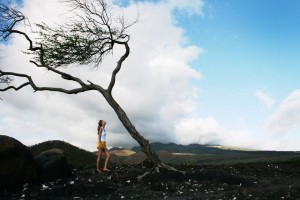 Freedom: The Place I call Home
Freedom: The Place I call Home
I used to think that going for a music festival abroad with friends, heading to the countryside for the weekend or even skydiving was the ultimate meaning of being free, of being independent. To be honest, and now looking in retrospective, many things I did were merely brief moments of freedom, or a sneak peak of what it could mean. I thought I was free, but I wasn’t. I was attached to all sorts of things and beliefs, so how could I ever be free?
I also used to think that home for me is Lisbon, the delicious and ever so beautiful city by the west side of lovely Europe. Well… in a way it is, but I also realized that more than a place, home is where my heart feels free. Being “home”, for me, is feeling “free”. So, as soon as I asked myself what was freedom for me, I hoped to find my way home.
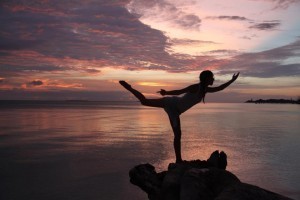 I believe I embarked on my journey to freedom when I decided to quit my job and travel the world. Not for being the brave gal everyone seemed to be proud of, the crazy Rita, the adventurous girl who isn’t afraid of a thing…. But for allowing myself to honestly and heartfelt answer the question “what do you want to do now?”
I believe I embarked on my journey to freedom when I decided to quit my job and travel the world. Not for being the brave gal everyone seemed to be proud of, the crazy Rita, the adventurous girl who isn’t afraid of a thing…. But for allowing myself to honestly and heartfelt answer the question “what do you want to do now?”
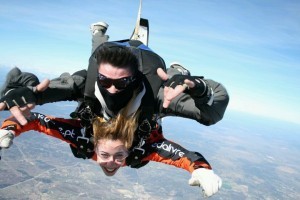 I know it isn’t a big deal for many, as the world is full of stories of brave, adventurous people who are willing to let go the safety of a 9 to 5 job along with all the commodities attached to it. But it was a big decision for me. I was giving my first step towards independence… I was going to be free! I was going to hang glide over Rio de Janeiro, go rafting in New Zealand, climb Machu Picchu, horse ride in Brazil, snorkel in Hawaii and drive a Vespa in Italy. It was going to be me, my passport and the whole world!
I know it isn’t a big deal for many, as the world is full of stories of brave, adventurous people who are willing to let go the safety of a 9 to 5 job along with all the commodities attached to it. But it was a big decision for me. I was giving my first step towards independence… I was going to be free! I was going to hang glide over Rio de Janeiro, go rafting in New Zealand, climb Machu Picchu, horse ride in Brazil, snorkel in Hawaii and drive a Vespa in Italy. It was going to be me, my passport and the whole world!
But freedom was a step further. I used to go abroad for one, two or even three weeks a year and although I would feel free for a while, I was still chained to a life in Lisbon, to a working schedule and to a serious of commitments that kept me attached to my “main” life. And in a similar way, even while traveling long term one would be stuck to too many plans.
So I found out that being free was to set myself free from all the plans I had. It was scary as hell to travel the world one day at a time, to decide things as I go, to not know what I would be doing the next day… But once I did that, I knew it: I was FREE!
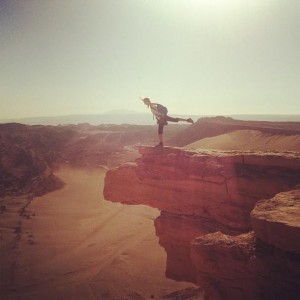 I learned to embrace what I have rather than what I might have. I started being present in the present and not live constantly in a preparation stage of something that will eventually come. Living in the future is a trap. I realized that I was always looking forward to something instead of fully enjoying what I was experiencing that very moment.
I learned to embrace what I have rather than what I might have. I started being present in the present and not live constantly in a preparation stage of something that will eventually come. Living in the future is a trap. I realized that I was always looking forward to something instead of fully enjoying what I was experiencing that very moment.
I used to spend an entire year wishing July (or whichever month) to come quickly so I could go to that amazing place I’d decided to visit. Now I travel as it comes, I live as it comes. I don’t skip a moment in favor of the next one (that might or might not come the way I expect)… I live every and each day as my last day (I know… it’s such a cliché, right?), I make the most of the present and guess what? Happiness doesn’t seem to fit in a plan, and every moment I am surprised with something truly, genuinely, unexpectedly amazing.
The moment I realized this I was a happy, free, independent girl who was ready to conquer the world.
I still am.
—
About the Author: Rita Andrade is a gummy bear addict who works as an art director and illustrator to support her even bigger addiction: traveling the world. Bit by bit, Rita is traveling her way around the world while sharing her experiences on her blog Where in the world is Rita? Also on Facebook and twitter (@Ritandtheworld)
The post Freedom: The Place I call Home appeared first on We Said Go Travel.
We Said Go Travel
We Said Go Travel is a global community of over sixteen hundred writers with articles from every continent.
Stories are shared with photos and video from a perspective of the transformative power of travel. We Said Go Travel has hosted live and online events as well as travel writing contests around the world. ...more
- Lisa Niver's profile
- 57 followers



